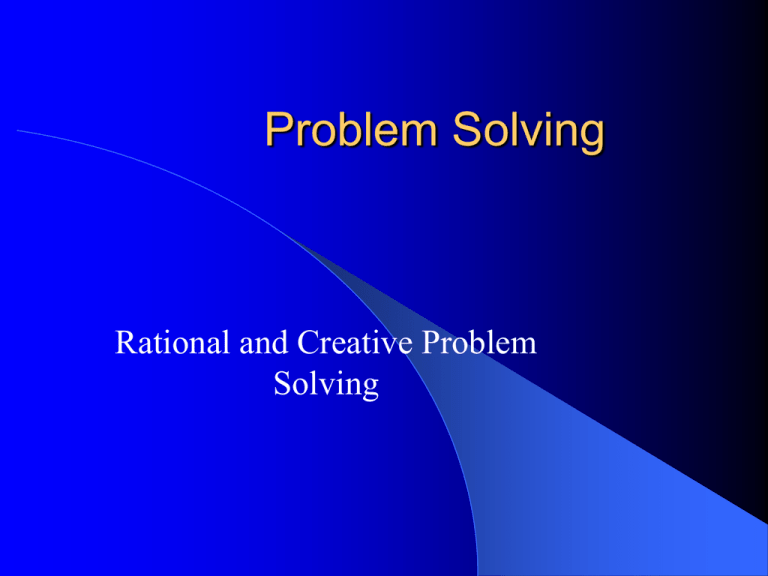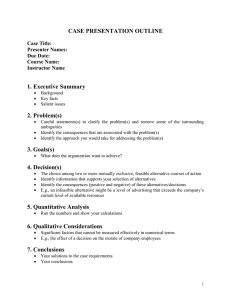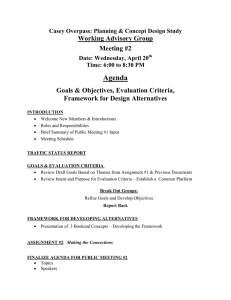Problem Solving Rational and Creative Problem Solving
advertisement

Problem Solving Rational and Creative Problem Solving If there were no problems there would be no need for managers Managerial Success Depends on Making the Right Decisions at the Right Times. Approaches Rationale problem solving Creative problem solving Rationale Problem Solving What are the steps? When is this the most effective method? A B C What Are the Steps for Rational Problem Solving? Problem Solving Decision Making Follow-through STEPS 1. 2. 3. Problem Awareness Define the problem Decision Making Generate alternative solutions Evaluate and select an alternative 4. 5. Implement Follow-through follow up on the solution Problem Awareness Establish Trust Clarify Objectives Assess the Current Situation Identify Problems – Routine Problems – Nonroutine Problems – Flowcharts Defining the problem Fact not opinion or speculation Broad participation Agree on what the problem is! State the problem explicitly Identify what “standards” or “expectations” were violated or need to be addressed Whose problem is this? Problem not solution Problem Definition Problems not solutions – Cause-and-effect Diagram Exhibit 9.3: Cause-and-effect Diagram Decision Making Establish Decision Making Criteria – Specific, Measurable, and Attainable – Complementary – Ethical – Acceptable Develop Action Alternatives Generate alternatives List all alternatives before evaluating them Broad participation Solutions must be consistent with organizational goals Synergy can turn bad ideas into good ones Keep focused on problem Constraints Alternatives are often evaluated as they arise Few of the many possible solutions are known The first acceptable solution usually is accepted Alternatives are based on what was successful in the past Decision Making (continued) Evaluate Benefits and Risks of Alternatives – Certainty – Known Risk – Uncertainty – Turbulence Decide on a Plan Decision Making (continued) • Decide on a Plan – Perfect Rationality – Bounded Rationality Constraints Satisfactory not optimal solutions are usually accepted Usually limited information about alternatives is available Solutions are often implemented before problem is defined Preferences usually aren’t known Implementation How can we maximize the probability that our solution will be accepted and fully implemented? Importance of feedback Engenders “buy-in” Evaluation: did it solve the problem? Constraints It may take a long time Acceptance by others not always forthcoming Resistance to change What should be followed-up and evaluated Politics! Action Plan Implementation Assign Tasks and Responsibilities Establish an Implementation Schedule – Gantt Chart Exhibit 9.5: Gantt Chart Follow-Through Establish Criteria for Measuring Success. Monitor the Results. Take Corrective Action. When Is Participation Appropriate for Decision Making? Degrees of Decision Participation – Autocratic – Consultative – Group Criteria for Participation Quality Requirements Criteria for Participation Quality Requirements Acceptance Requirements Criteria for Participation Quality Requirements Acceptance Requirements Time Requirements Choosing the Appropriate Degree of Participation Exhibit 9.7: Decision Tree for Decision Making Participation Advantages and Disadvantages of Group Decision Making Advantages and Disadvantages of Group Decision Making (continued) Advantages Making Decisions in Groups Disadvantages of Making Decisions in Groups – More Time Investment – Individual Agendas – Shared Responsibility – Pressure to Conform Groupthink Advantages and Disadvantages of Group Decision Making (continued) • The Manager’s Role Is Making Group Decision Effective. When rationale problem solving won’t work… Outcomes unpredictable Sufficient information isn’t available Means-ends connections aren’t clear try… Creative problem solving Getting past our personal (conceptual) roadblocks and finding creative solutions Encouraging Creativity Characteristics of Managers Who Generate Creativity – – – – – – – Absorb Risks Can Live with Half-developed Ideas Stretch Normal Policies Good Listeners Don’t Dwell on Mistakes Trust Their Intuition Are Enthusiastic and Invigorating Encouraging Creativity Promoting Creative Thinking in Organizations – Brainstorming – Nominal Group Technique – Delphi Technique – Group Decision Support Systems (Continued) Conceptual blocks Constancy: one way of looking at things – One thinking language Conceptual blocks Commitment: sticking with it – Perceptual Stereotyping based on past experience – Ignoring commonalities Conceptual blocks Compression: narrow focus – Artificial constraints – Separating figure from ground Nine dot problem Conceptual blocks Complacency: fear, laziness, ignorance – Non-inquisitiveness – Bias against thinking Removing the roadblocks Focus is on improving one’s mental abilities and habits and cultivating dormant skills Stages in creative thought 1. Preparation Gathering data Defining the problem Generating/examining alternatives 2. 3. 4. Incubation Illumination verification Gathering data “dance around the problem” Improving problem definition Make the strange familiar and familiar strange – Synetics – Analogies: personal, direct, symbolic, fantasy Elaborate on the definition – Is there anything else? – Is the reverse true? – Is there a more general problem? – Can it be stated differently? – Who sees it differently? – What past experience is this like? Reverse the definition – Janusian thinking: Thinking contradictory thoughts at the same time Generating more alternatives Fluency and flexibility Defer judgment: Brainstorming Expand current alternatives: subdivision Combine unrelated attributes – Morphological forced connections – Relational algorithm Foster innovation Pull people apart; put people together Monitor and prod Reward multiple roles Tips Break out of your routine: give yourself a break Make thinking a priority Talk to other people about ideas and about your problems Read outside of your area of expertise Avoid black holes


